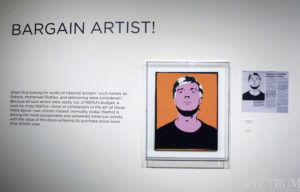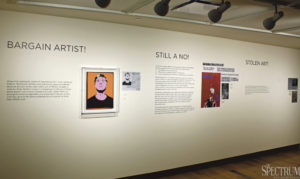
The Stella (left) and Rosenquist (right) are two examples of major national artist acquisitions made in the first 10 years of the Gallery.
In 1969, North Dakota State students began what would later become the Memorial Union Gallery.
Forty-eight years later, Kirbie Sondreal, a senior majoring in public history, is telling their story in her curated show, “Origin Story.”
“Origin Story” describes the past of the Memorial Union Gallery through works selected from the student art collection, images procured from the NDSU Archives and articles published in The Spectrum.
The project began when Sondreal was working on a collections manual this past summer. She noticed the history of the Gallery was fragmented. Since it was created, it has changed hands so often that no one person kept accurate records of acquired works and the stories that have flavored the Gallery’s past.
For example, in 1907, North Dakota Agricultural College president Herman O. Fjelde commissioned Norwegian sculptor Gustav Vigeland to create a bronze statue depicting Theodore Roosevelt. Fjelde wanted to connect the strong Norwegian heritage in the state with one of its historical icons.
The statue was supposed to be large — larger, even, than the bronze bison statue welcoming students onto NDSU’s campus. However, the statue was never created to the scale it was intended. In fact, little was ever written about this impressive feat of sculpting that was supposed to stand on NDAC’s campus.
“The only reason I found anything about it was because I was doing an acquisition report this summer, so just like taking some records on the small statue which is in Old Main,” Sondreal said. “I saw that the creation date was way after the original artist died. He died in the 1920s, or something, and the statue date was like 1972. I typed it into Google and I found one tiny paragraph on a Theodore Roosevelt website about it. Then, the more digging I did, the more I found out this crazy story about a giant sculpture made by some unknown, but very famous, Norwegian artist that was supposed to be on campus here, and done huge. I had no idea about it. Nobody else knew anything about it.”
The entire exhibit features, or is in some way influenced by, crazy stories such as these that Sondreal found interesting as she dug further into the Gallery’s past.

The acquisition of Andy Warhol’s ‘Self Portrait’ was made in 1972 with the help of James Demetrion, an art consultant from Des Moines, Iowa.
In addition to actual articles Sondreal featured, the artwork she chose to highlight was specifically selected: a timeline along the Gallery’s west wall is pinpointed by six different pieces of artwork, from six different years, that were acquired by the Gallery in its formative years.
“Every piece was chosen very carefully and very intentionally,” she explained. “They didn’t want to just get art for the sake of getting art. They were super selective and thinking about the long term. Through this timeline, it’s kind of to show how slow and meticulous they were about it.”
The first major national acquisition for the Gallery was made in 1970, when they purchased “Untitled” by Frank Stella. After that, the Gallery purchased a Warhol in 1972, a Rosenquist in 1973 and an Ernst in 1976.
“I felt like the Gallery got started on really noble roots,” Sondreal said. “They had vision going in. They knew what they wanted, and they were very intentional about all the first purchases and just how they went about things. But I feel like, over the years, that kind of got hidden as time went on and just kind of got forgotten. Through this show, we’re able to kind of bring that back. The fact that the Gallery even got created, it was students who moved to procure an art collection. It was students who wanted this to happen. And I think that’s really cool. The fact that it happened alone is huge. And just how much has gone on through the time, it has such interesting history. Just being able to highlight that and make people aware of everything that’s gone into this place in this collection.”
Some of these major acquisitions were made with the help of James Demetrion, an art consultant from Des Moines, Iowa.
“After I looked at The Spectrum articles, I found out that he was an art consultant that the Gallery had hired when they first started looking to acquire national pieces,” Sondreal explained. “So, the Warhol, the Stella, Rosenquist, all of these were made through him. Because as a tiny gallery in North Dakota, it’s kind of hard for us to have the resources, especially at that time when it was you had to go there to get this stuff, to be able to search the market, see what was available, see if it was available at a good cost.”
Originally, the Gallery was supposed to only be for ’70s abstract impressionist Clyfford Still. However, plans fell through when the Union Board and Student Senate disagreed with the terms of the agreement and the secrecy surrounding it. When Still heard about the adjustments to his original conditions, he retracted his offer, leaving the Gallery a space for all types of artists.

Kirbie Sondreal, curator of the ‘Origin Story’ exhibit, focused on interesting stories of the Gallery’s past, including the acquisition of a Warhol piece, the breakdown of a deal with Clyfford Still and stolen artwork.
“Basically, all the stories that are highlighted in this are crazy things that I found out as I did the research,” Sondreal said.
Sondreal’s quest of piecing together the history of the Gallery was less based on materials she found in the archives and media sources and more on the accounts of previous Gallery directors, students who worked with the Gallery and others involved in the beginning of the Gallery, like Demetrion.
“I kept track of the names, and after awhile I had a spreadsheet full of names. I started going online and using shady internet background search things, and tried to track down as many people as I could,” Sondreal said. “I got to talk with some of the early directors of the gallery, I’ve been emailing with Jim Demetrion … kind of filling in some of the blanks for me. I spoke to one student who was involved when she was in college. She’s retired. I’ve been able to speak with these people; I’ve been recording my interviews with them — they’re just done through phone or, in Jim’s case, through email. I feel like it’s important for us to keep, important beyond this show even, just to have that experience and the early history down.”
“Origin Story” is on display through Oct. 12.
For more information on the MU Gallery, visit their website.
